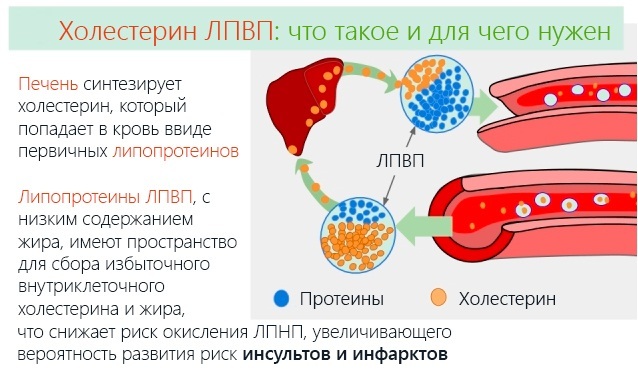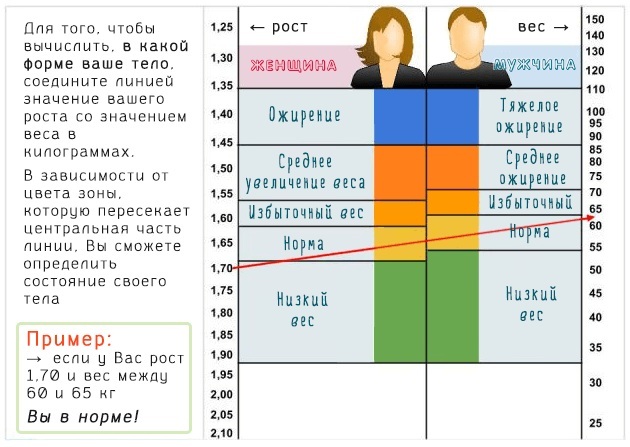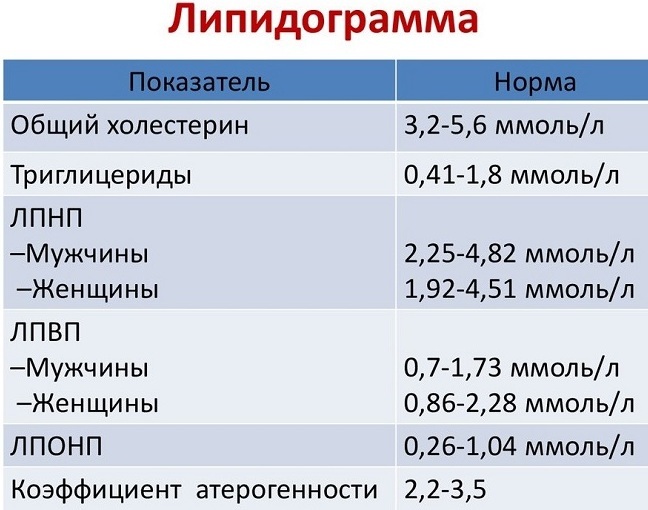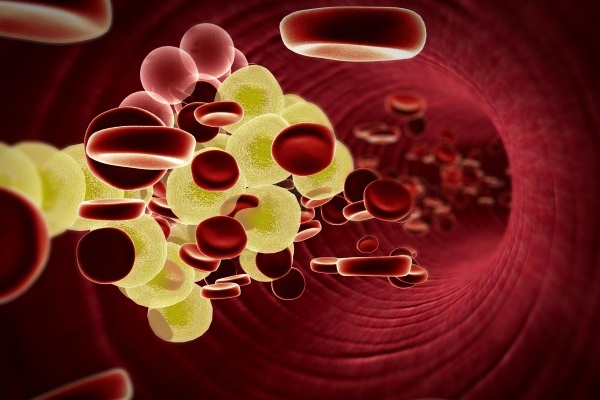Lipids (or fats) ensure the normal development and functioning of the body, but their level must be monitored. For this, there is a special analysis to determine the lipid profile.
Record content:
- 1 The role of fat in the body
- 2 What is lipid profile, lipid profile?
- 3 What indicators are included in the study?
- 4 Comparison with a foreign lipid profile
- 5 When is a lipid profile prescribed?
- 6 Preparing for a blood test
- 7 How is the analysis done?
-
8 Normal Indicator Tables
- 8.1 In adult women and men
- 8.2 In children
- 8.3 During pregnancy
-
9 Decoding the results
- 9.1 Increased performance
- 9.2 Decreased performance
- 10 Influence of gender and age on the result
- 11 Where to do a lipid profile test? Average prices
- 12 Lipid profile video
The role of fat in the body
Fats are the main building blocks (along with proteins and carbohydrates) necessary to maintain human health. The membranes of absolutely all cells in the body consist of a double layer of lipids, and therefore a lack of fat leads to a violation of the formation of cell membranes.
Without fats, the normal assimilation of fat-soluble vitamins (A, E, D, K) is impossible, and therefore carrots, which have a high vitamin A content, are recommended to be eaten together with vegetable oil.
Lipids are also needed for the synthesis of hormones, especially sex hormones. With a lack of fat in the diet, reproductive function (infertility) is disturbed, women lose their periods, problems with skin and nails begin.
However, excess fat in your diet (especially unhealthy trans fats), in addition to causing obesity, also causes development of blood vessel diseases and causes deviations in the functioning of vital organs, and in severe cases leads to of death.
What is lipid profile, lipid profile?
Lipid profile is an enzymatic analysis of blood serum to determine the level of the content of different types of lipids in it and identify diseases that develop as a result of disorders lipid metabolism.
The lipid profile has several synonyms: lipid profile, lipid spectrum, lipid (lipid-) status, or screening.
Screening is carried out in order to:
- assessing the likelihood of the development and diagnosis of heart and vascular diseases;
- observation of patients (on a regular basis) with previously diagnosed vascular and heart pathologies and diabetes mellitus;
- observation of patients with an increased or high risk of cardiovascular pathologies;
- evaluating the effectiveness of previously prescribed diet and drug therapy.
People over 20 are advised to get tested every 5 years. Upon reaching the age of 45, it is recommended to take a lipid profile annually.
What indicators are included in the study?
Lipid profile is a complex analysis in which several indicators are examined at once:
| LDL (low density lipoprotein) | They "move" in the direction from the liver to the tissues and peripheral vessels of the body. Due to their low density, they are able to remain on the walls of blood vessels, causing them to constrict. LDL is a “bad” type of lipid. |
| HDL (high density lipoprotein) | These are "good" lipids that bind the molecules of all cholesterol and deliver it to the liver cells, from where they are then excreted. LDL is not able to settle and adhere to the walls of blood vessels. In addition, due to their high density, they “cleanse” the vessels by capturing the molecules of “bad” cholesterol. |
| Triglycerides | Triglycerides are neutral fats that are the main source of energy. Under the influence of certain factors, they are able to turn into LDL, and therefore, it is important to monitor their level in blood serum. |
| Total cholesterol | This is the total value of all types of cholesterol molecules that are found in the blood. Every day, cholesterol (most of it) is synthesized in the body and a small amount is supplied with food, and then partially excreted in the bile. Therefore, there is the term "cholesterol balance", which means the level of cholesterol, at which there is no risk of vascular damage, but the substance is sufficient for the normal functioning of cells. |
| Coefficient (index) of atherogenicity | This coefficient connects all the readings of the lipid profile and determines the predisposition to atherosclerosis. It is calculated by subtracting the HDL value from the total cholesterol value and dividing the result by the HDL value: CA = total cholesterol - HDL / HDL. |
The listed indicators are mandatory (basic).
In some cases, an extensive lipid profile is performed, which also includes the following indicators:
- VLDL (very low density lipoproteins) are lipoproteins that have the greatest ability to settle on the internal vascular walls.

- Lipoprotein (a) is a subclass of lipoproteins, most of which are protein and the least of which is fat. In terms of composition, lipoproteins (a) are similar to LDL, therefore, with an increase in their concentration, the risk of developing vascular lesions increases.
- Apolipoprotein A1 is a protein that is the main constituent of HDL. The normal level of this substance helps to prevent the deposition of molecules of "bad" cholesterol on the walls of blood vessels.
- Apolipoprotein B is a protein that is part of VLDL and LDL. Provides the metabolism of cholesterol molecules in the body.
Comparison with a foreign lipid profile
In many overseas clinics, lipid screening is done differently. For the study, venous blood is taken, but the patient may not fast before the procedure.
Also, abroad they do not make a lipidogram in children and adolescents, since they have a minimal risk of developing cardiovascular diseases due to high cholesterol. However, the American Academy of Pediatrics recommends screening children 9-11 years old in order to diagnose hereditary hypercholesterolemia and other diseases of the heart and blood vessels with genetic character.
When is a lipid profile prescribed?
The analysis is prescribed for patients with the following indications:
| Cardiovascular diseases | Atherosclerosis, arterial hypertension, ischemia, heart attack or stroke. |
| Diseases of the biliary organs and tracts | Chronic liver failure, liver cirrhosis, hepatitis of any type, pancreatitis, oncological organ damage. |
| Diseases of the endocrine system | Hypothyroidism, thyroiditis |
| Autoimmune diseases | Rheumatism, rheumatoid arthritis |
| Kidney disease | Chronic renal failure, nephrotic syndrome |
| Blood pathologies | Anemia, multiple myeloma, sepsis |
| Metabolic diseases | Hereditary dyslipidemia, diabetes |
A lipidogram is most often prescribed for already identified diseases, to establish a diagnosis or to find out the reasons for the development of a particular pathology.
Also, regardless of age and diagnosed diseases, the analysis is prescribed in the presence of the following indications:
- frequent smoking and alcohol consumption (especially alcoholism);
- obesity or high BMI;

- sedentary lifestyle;
- unhealthy diet with a predominance of fats and fast carbohydrates in the diet;
- long-term use of hormonal oral contraceptives;
- waist circumference for women is more than 80 cm, for men - more than 94 cm.
Preparing for a blood test
In order for the results of the study to be as reliable as possible, it is necessary to adhere to the rules of preparation:
- Girls and women of childbearing age are recommended to be tested during the ovulatory period (on the 14-20th day of the cycle).
- The day before the analysis, you need to exclude any physical activity, emotional stress. If physical or emotional fatigue is felt on the day of blood donation, it is recommended to postpone the analysis for 2-3 days.
- The analysis must be taken strictly on an empty stomach, so the last meal should take place at least 12 hours in advance. before donating blood (but not more than 14 hours). On the day of the analysis, a small amount of pure non-carbonated water is allowed.
- Also in 12 hours. before the procedure, you must stop smoking.
- By agreement with the doctor, 3-14 days before the lipidogram, you should stop taking medications. If this is not possible, then before donating blood, it is necessary to tell the doctor about taking any medications (this will help correctly interpret the study result, taking into account the intake of medications, since some of them affect the level of fat in blood).

- You should not follow a special diet before the analysis - you need to eat as usual. But 1 day before the procedure, fatty and fried foods should be excluded from the diet (they can artificially increase the amount of fat in the blood serum, which will distort the results). The last meal on the evening before blood donation should be made light - vegetable broth or salad, baked fish, omelet.
- Before entering the laboratory, you should sit for 5-7 minutes, catch your breath and calm down.
Blood for lipid screening cannot be donated on the day of fluorography and X-ray examination, ultrasound, colonoscopy and any physiotherapy procedures.
How is the analysis done?
Blood is donated strictly in the morning (approximately from 8:00 to 11:00, since various biochemical processes in the human body depend on the time of day).
The blood sampling procedure is carried out in the usual way:
- The patient is pulled over the forearm with a belt and asked to clench the fist for 10-20 s.
- Then the area near the vein is disinfected, a needle is inserted and blood is drawn into a test tube.
- After that, the tube with the obtained material is immersed in a centrifuge, and then sent to the laboratory for further research.
The results are prepared within 1-2 days.
Normal Indicator Tables
The values of lipid screening indicators in adults, adolescents and children differ due to the characteristics of nutrition and hormonal activity.
In adult women and men
| Index | Age (by years) | Norm in women (mmol / l) | The norm in men (mmol / l) |
| LDL | 18-20 | 1,52-3,55 | |
| 20-40 | 1,94-4,45 | 1,7-4,45 | |
| 40-60 | 2,31-5,44 | 2,25-5,26 | |
| 60 and above | 2,15-5,44 | 2,59-5,8 | |
| HDL | 18-20 | 0,85-2,0 | |
| 20-40 | 0,88-2,12 | ||
| 40-60 | 0,96-2,35 | 0,72-1,44 | |
| 60 and above | 0,98-2,48 | 0,98-1,94 | |
| Triglycerides | 18-20 | 0,42-1,48 | 0,45-1,81 |
| 20-40 | 0,40-1,70 | 0,5-3,50 | |
| 40-60 | 0,44-2,63 | 0,62-3,23 | |
| 60 and above | 0,50-2,70 | 0,65-2,90 | |
| Total cholesterol | 18-65 | 2,8-5,9 | |
| 65 and above | 3,6-7,1 |


Atherogenic index:
- 1.5-2.5 - the norm;
- 2.5-3 - low risk;
- 3-4 - moderate probability;
- more than 4 - a very high probability of developing atherosclerosis (most likely, a person already has this pathology).
In children
| Index | Child's age | Rate (mmol / l) |
| LDL | Up to 14 years old | 1,6-3,60 |
| HDL | 0,90-2,0 | |
| Triglycerides | 0,30-1,40 | |
| Total cholesterol | The first 30 days of life | 1,30-4,40 |
| 1-12 months | 1,50-4,90 | |
| 1-14 years old | 2,80-5,20 |
During pregnancy
During pregnancy, the body undergoes hormonal changes and changes in biochemical processes. Therefore, the lipid profile values increase by 1.5 times or more.
| Index | Rate (mmol / l) |
| LDL | 1,90-5,50 |
| HDL | 0,80-2,10 |
| Triglycerides | 1,70-2,75 |
| Total cholesterol | Does not exceed 6.50 |
Decoding the results
The values of the lipid profile are studied and deciphered by the doctor who ordered the study. In some cases, a transcript (if there are deviations) and recommendations for the patient are already written on the form with the results.
Increased performance
If an increased content of LDL is found in the patient's blood, this indicates that the person is susceptible to the development of atherosclerosis. Too much excess of the norm indicates the presence of this disease.
Despite the fact that HDL is beneficial, their excess content in the blood serum indicates a hereditary disorder of fat metabolism, intestinal pathology.
Excess triglycerides are caused by heart disease, alcoholism, diabetes and obesity. Also, viral hepatitis and kidney disease can affect the change in their level.
High cholesterol levels (the scientific name for this condition is called hypercholesterolemia) is caused by poor diet, bad habits, obesity and lack of physical activity. In addition, hypercholesterolemia can develop due to disorders in the endocrine system, pathologies of the liver and kidneys, biliary organs and intestines.
In case of suspicion of diseases of the digestive tract and biliary system, a lipidogram of feces is indicated.
With an increase in the coefficient of atherogenicity, adherence to a diet, exercise and rejection of bad habits is shown. In severe cases, medications are prescribed to lower the level of “bad” cholesterol and triglycerides in the blood.
Decreased performance
Reducing the level of "bad" cholesterol is rare. If the other 3 lipid screening indicators are normal, then a slight decrease in LDL is not dangerous.
A low or low HDL level indicates that in the absence of therapy, the patient will soon develop atherosclerosis.
The reasons for the decrease in the concentration of "good" cholesterol can be:
- endocrine diseases;
- liver and kidney disease;
- hereditary disorders of the absorption of fats.

Triglyceride levels can decrease due to autoimmune diseases, ischemia, endocrine disorders. Also, their concentration is affected by the use of certain medications (vitamin C, heparin, hormonal drugs).
Low blood cholesterol can be caused by prolonged fasting, diet, or pathologies such as:
- autoimmune diseases;
- anemia;
- heart failure;
- violations of the absorption function of the small intestine;
- disorders of the thyroid gland.
Influence of gender and age on the result
Lipid profile is a study, the results of which depend not only on nutrition, but also on the gender and age of the patient, therefore, when interpreting the results, these factors must be taken into account.
Women in the reproductive period are less susceptible to changes in the concentration of cholesterol due to the fact that it is necessary for the synthesis of estrogen. During menopause, the production of "female" hormones gradually decreases, cholesterol ceases to be consumed and accumulates in the blood serum, and later - on the inner side of the vascular walls.
In men 40-50 years of age, the risk of atherosclerotic lesions is 2-3 times higher due to the fact that their cholesterol is not is used to synthesize hormones, respectively, the level of the substance in the blood may be higher than normal.
Children under 14-16 years old very rarely have an exceeded cholesterol level due to the fact that the body especially needs fats. With age, the metabolism in the body of both women and men slows down, as a result of which the rate of digestion, assimilation and excretion of fats decreases. Therefore, the older the person, the higher the risk of retaining cholesterol particles on the vascular walls and the formation of "plaques" on them.
Where to do a lipid profile test? Average prices
The lipid profile is a common test. Any large and well-known medical laboratories have it in their list of research. The cost of a basic analysis is 500-900 rubles. Extended lipodogram, taking into account analyzes for 3 additional indicators, will cost 2000-3000 rubles.
The lipid profile is the only highly informative analysis that helps assess the risk of developing atherosclerotic conditions and diagnose many diseases. But for this study to be accurate, preliminary preparation is necessary.
Lipid profile video
Analysis of the lipid profile analysis:



